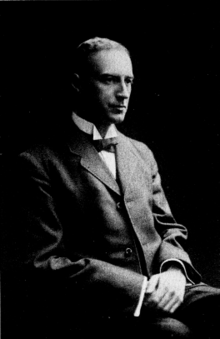Wallace Clement Sabine
| Wallace Clement Sabine | |
|---|---|
 | |
| Born | June 13, 1868 |
| Died | January 19, 1919 (aged 50) |
| Nationality | American |
| Fields | Acoustics |
| Alma mater | Harvard University |
| Doctoral advisor | John Trowbridge |
| Doctoral students | Percy Bridgman |
Wallace Clement Sabine (June 13, 1868 – January 10, 1919) was an American physicist who founded the field of architectural acoustics. He graduated from Ohio State University in 1886 at the age of 18 before joining Harvard University for graduate study and remaining as a faculty member. Sabine was architectural acoustician of Boston's Symphony Hall, widely considered one of the two or three best concert halls in the world for its acoustics.[1]
Career
Sabine's career is the story of the birth of the field of modern architectural acoustics. In 1895, acoustically improving the Fogg Lecture Hall, part of the recently constructed Fogg Art Museum, was considered an impossible task by the senior staff of the physics department at Harvard. The assignment was passed down until it landed on the shoulders of a young physics professor, Sabine. Although considered a popular lecturer by the students, Sabine had never received his Ph.D. and did not have any particular background dealing with sound.
Sabine tackled the problem by trying to determine what made the Fogg Lecture Hall different from other, acoustically acceptable facilities. In particular, the Sanders Theater was considered acoustically excellent. For the next several years, Sabine and a group of assistants spent each night moving materials between the two lecture halls and testing the acoustics. On some nights they would borrow hundreds of seat cushions from the Sanders Theater. Using an organ pipe and a stopwatch, Sabine performed thousands of careful measurements (though inaccurate by present standards) of the time required for different frequencies of sounds to decay to inaudibility in the presence of the different materials. He tested reverberation time with several different types of Oriental rugs inside Fogg Lecture Hall, and with various numbers of people occupying its seats, and found that the body of an average person decreased reverberation time by about as much as six seat cushions. Once the measurements were taken and before morning arrived, everything was quickly replaced in both lecture halls, in order to be ready for classes the next day.
Sabine was able to determine, through the experiments, that a definitive relationship exists between the quality of the acoustics, the size of the chamber, and the amount of absorption surface present. He formally defined the reverberation time, which is still the most important characteristic currently in use for gauging the acoustical quality of a room, as number of seconds required for the intensity of the sound to drop from the starting level, by an amount of 60 dB (decibels).
His formula,[2] if all units are SI, is
where
- T = the reverberation time
- V = the room volume
- A = the total absorption area
By studying various rooms judged acoustically optimal for their intended uses, Sabine determined that acoustically appropriate concert halls had reverberation times of 2-2.25 seconds (with shorter reverberation times, a music hall seems too "dry" to the listener), while optimal lecture hall acoustics featured reverberation times of slightly under 1 second. Regarding the Fogg Museum lecture room, Sabine noted that a spoken word remained audible for about 5.5 seconds, or about an additional 12-15 words if the speaker continued talking. Listeners thus contended with a very high degree of resonance and echo.
Using what he discovered, Sabine deployed sound absorbing materials throughout the Fogg Lecture Hall to cut its reverberation time and reduce the "echo effect." This accomplishment cemented Wallace Sabine's career, and led to his hiring as the acoustical consultant for Boston's Symphony Hall, the first concert hall to be designed using quantitative acoustics. His acoustic design was successful and Symphony Hall is generally considered one of the best symphony halls in the world.
The unit of sound absorption, the sabin, was named in his honor.
See also
- Acoustics
- Wallace Clement Sabine Medal of the Acoustical Society of America
References
- ↑ Gerrit Petersen; Steven Ledbetter & Kimberly Alexander Shilland (June 26, 1998). "National Historic Landmark Nomination: Symphony Hall" (PDF). National Park Service. Retrieved 2009-06-26.
- ↑ http://www.acoustics-engineering.com/sabin/wcsabine.htm
- Reverberation and the Art of Architectural Acoustics
- Emily Thompson, The soundscape of modernity : architectural acoustics and the culture of listening in America, 1900 - 1933 (Cambridge, Mass.: MIT Press, 2002).
- F. Alton Everest, Master Handbook of Acoustics, Fourth Edition, 2001
- Wallace Clement Sabine, Collected Papers on Acoustics (New York: Dover Publications, 1964) [first published by Harvard University Press, 1922]
- January 10, 1919: Death of Wallace Sabine, pioneer of architectural acoustics, American Physical Society News 20, January (2011).
External links
| Academic offices | ||
|---|---|---|
| Preceded by Benjamin Osgood Peirce |
Hollis Chair of Mathematics and Natural Philosophy 1914-1919 |
Succeeded by Theodore Lyman |